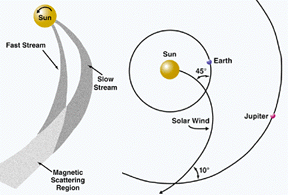|
What is solar wind?
 The
solar wind generated by our sun is quite different from Earth's
surface winds, which are created by differences in atmospheric
pressures. This "wind" carries about one million
tons of hot plasma, electrically-charged gas particles, at
a temperature of about 100,000 Kelvins, away from the sun
every second. Solar wind plasma is a mixture of mostly protons
(H+) with some helium nuclei (He2+)
and electrons to electrically balance these positive ions.
About 0.1% of the solar wind is made up of ions of other elements,
including carbon, nitrogen, oxygen, neon, magnesium, silicon,
and iron as well as almost all of the other known elements.
The Genesis mission hopes to analyze nearly all elements from
lithium (atomic number 3) to uranium (atomic number 92). The
solar wind generated by our sun is quite different from Earth's
surface winds, which are created by differences in atmospheric
pressures. This "wind" carries about one million
tons of hot plasma, electrically-charged gas particles, at
a temperature of about 100,000 Kelvins, away from the sun
every second. Solar wind plasma is a mixture of mostly protons
(H+) with some helium nuclei (He2+)
and electrons to electrically balance these positive ions.
About 0.1% of the solar wind is made up of ions of other elements,
including carbon, nitrogen, oxygen, neon, magnesium, silicon,
and iron as well as almost all of the other known elements.
The Genesis mission hopes to analyze nearly all elements from
lithium (atomic number 3) to uranium (atomic number 92).
The solar wind forms from systems of electrical currents
within the sun's corona, the outermost layer of the sun's
atmosphere, and behaves like an electrically conducting fluid.
These incredibly dilute, superheated solar wind gases reach
millions of miles into space. Voyager 1 observed evidence
of solar wind at a distance greater than 85 AU, well past
the orbit of Pluto.
The corona's motion is synchronized with the solar activity
cycle, changing shape from a jagged ring around the sun during
the peak of the cycle to wispy plumes and streamers that reach
millions of miles into space at the end of the cycle. These
plasma-containing streamers in the corona are the origin of
the dense, lower-speed component of the solar wind. During
periods of low solar activity, a very fast type of solar wind
flows from relatively stationary "coronal holes"
over the north and south poles of the sun.
 These
solar wind streams are carried at different speeds varying
from 300 to 1000 km/sec, independent of the wind's distance
from the sun. Because they are carried at different speeds,
the streams collide and rebound, producing low magnetic regions
and regions in which the magnetic field is amplified. These
solar wind streams are carried at different speeds varying
from 300 to 1000 km/sec, independent of the wind's distance
from the sun. Because they are carried at different speeds,
the streams collide and rebound, producing low magnetic regions
and regions in which the magnetic field is amplified.
The plasma particles that have enough kinetic energy to escape
the sun carry its magnetic field into interplanetary space.
Its magnetic field strength is about 10-4 of Earth's
and its strength decreases as the distance between the plasma
and the sun increases.
The density of the solar wind varies between 1 and 10 particles/cm3
and it, also, decreases as it moves farther from the sun.
Solar Max activity can cause large increases in density, however.
After escaping from the sun's gravitational field, the solar
wind flows outward radially, like water from a rotating garden
sprinkler. Each drop moves straight out from the source, but
the pattern rotates. When it reaches the Earth, the spiral
makes an angle of about 45 degrees with a radial line from
the sun and the solar wind is traveling over one million miles
per hour.
For a more detailed research data of solar wind properties,
click on http://www.gps.caltech.edu/genesis/DocumentG.html
NEXT
For a more technical description, take a Closer
Look at
The Structured Sun and Solar Max: At the Core of the Matter.

|
